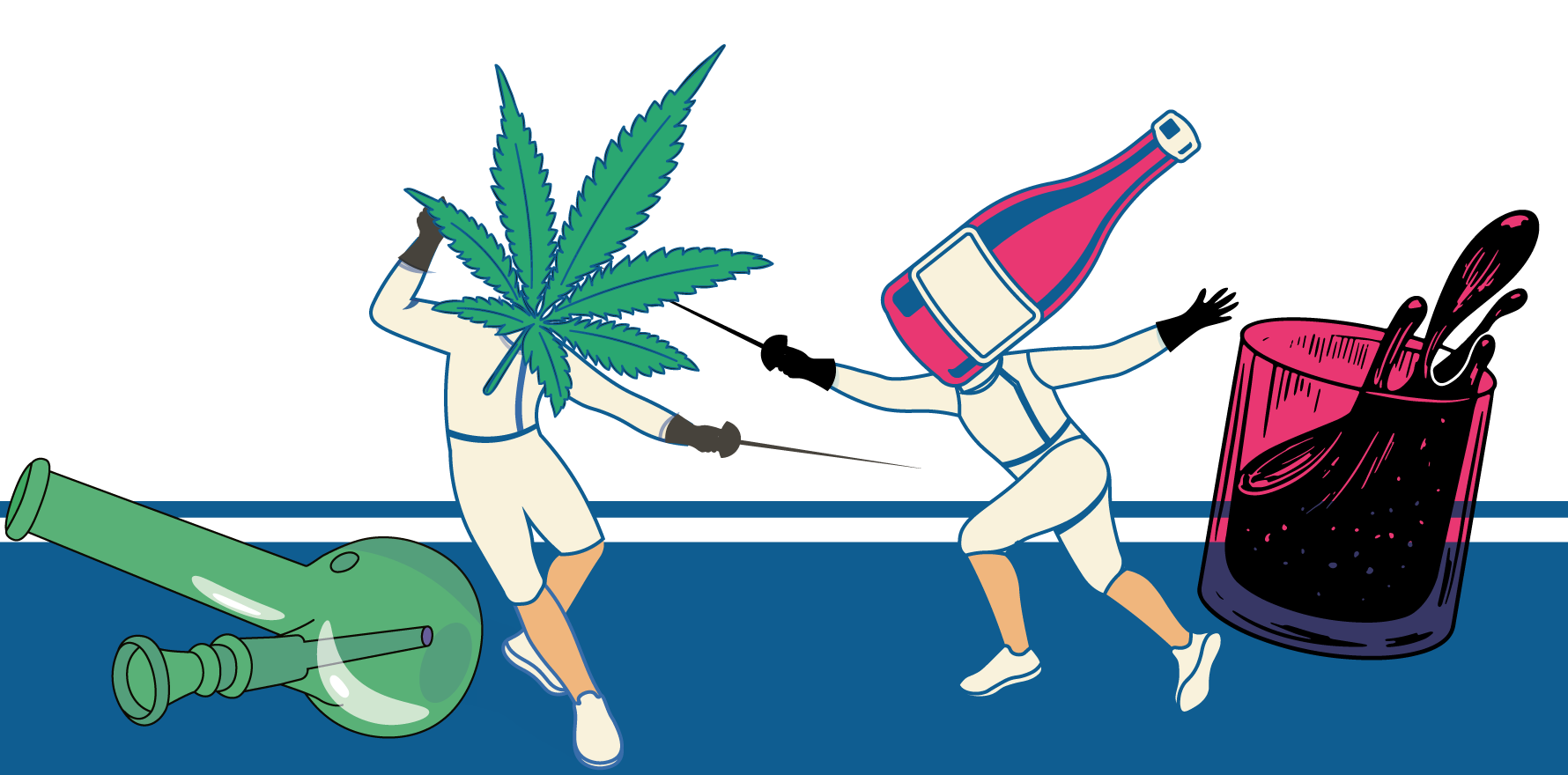Two GPs and addiction medicine specialists are trying to improve access to safe, evidence-based treatments for the highly stigmatised condition.
Alcohol use disorder is a big issue in Australia, but a pair of Melbourne-based doctors are striving to build a community encouraging the use of safe and effective pharmacological treatments.
Drinking alcohol has long been seen as a key part of social and cultural activities in Australia, despite the known harmful effects of chronic alcohol consumption. The Australian Institute for Health and Welfare estimated the social cost of alcohol use – including the cost of absenteeism, crime, total healthcare costs and premature death – in the 2017-18 financial year at $67 billion.
More recently, the AIHW reported that 43% of people who received treatment for alcohol and other drug use in the 2022-23 financial year listed alcohol as the principal drug of concern. This equates to over 90,000 alcohol-related treatment episodes over a 12-month period – a figure that has consistently increased over the past decade.
Most of these episodes are treated with counselling or withdrawal management in the first instance, with approximately 3% of people with alcohol dependence receiving pharmacological treatment – and only 15-25% of this 3% are given the recommended three months of treatment.
Speaking to delegates at last month’s General Practice in Addiction Medicine conference, Dr Paul MacCartney, a Melbourne-based GP and addition medicine specialist, described this gap as the biggest treatment disparity among all mental health conditions, and went on to say so few patients receiving pharmacological treatment for alcohol use disorder was “a huge elephant in the room”.
Stigma, fears and knowledge gaps
Dr MacCartney felt there were multiple reasons why doctors don’t use pharmacological treatments for alcohol use disorder. One such reason is the historical hangover of viewing addiction as a moral problem (where the individual is responsible for their disorder and its resolution) as opposed to a medical problem (where the individual is a victim of a disease that requires proactive assistance from healthcare professionals).
Other doctor-related reasons include the belief that there are a limited number of treatment options available for patients and that those don’t work very well; the fear their prescribing activity will be investigated by AHPRA; and the worry that they will be swamped by patients if word gets around that they are someone who prescribes these treatments.
And then there are the patient-related reasons, which mostly relate to the aforementioned belief that people with a substance use disorder only have themselves to blame.
“Patient-related ideas [include] that these patients are doctor shoppers, demanding, violent, manipulative – that they’re just hopeless. They’re a bit weak, pathetic and unmotivated,” Dr MacCartney said.
While some of these reasons are more challenging to address than others, Dr MacCartney and fellow GP and addiction medicine specialist Dr Dean Membrey feel educating GPs about the range (and efficacy) of pharmacological treatment options for alcohol use disorder is “low-hanging-fruit”.
What’s in the pharmacological toolbox?
First- and second-line pharmacological treatments for alcohol use disorder include naltrexone, acamprosate, baclofen, topiramate, ondansetron and prazosin.
A systematic review and meta-analysis involving more than 20,000 participants over 118 clinical trials, published last year in JAMA, found that naltrexone and acamprosate reduced alcohol consumption when prescribed in conjunction with psychosocial interventions.
The findings of a Cochrane review, also published last year, were somewhat more reserved. The review concluded there was very-low to moderate-certainty evidence suggesting combined pharmacological and psychological interventions were effective at reducing harmful alcohol intake in low- and middle-income countries.
Dr Membrey echoed the importance of providing psychosocial support in addition to prescribing pharmacological treatments.
“People with alcohol use disorder need to be considered in a biopsychosocial sense,” he said. “We need to work out what’s contributing to their drinking. People often need support around mental health or some other form of engagement with trauma counsellors to deal with the other things that may be contributing to their alcohol use.”
There is also a growing body of evidence suggesting the GLP-1 receptor agonists semaglutide (Ozempic, Wegovy) and tirzepatide (Mounjaro, Zepbound) may also be potential treatment options for alcohol use disorder.
Earlier this year American researchers reported that semaglutide, compared to other non-GLP-1 anti-obesity or anti-diabetes medications, reduced the incidence and recurrence of alcohol use disorders in obese individuals (with and without a prior history of alcohol use disorders) and people with type 2 diabetes.
The findings of the retrospective cohort study, which examined electronic medical record data for over 600,000 patients (roughly 70,000 of whom were prescribed semaglutide), were published in Nature Communications.
“The underlying mechanisms have not been fully delineated but are likely to involve modulation of the brain dopamine reward system via GLP-1 receptors, which are present both in the ventral tegmental areas, where dopamine neurons are located, and in the nucleus accumbens, which is the main projection of VTA dopamine neurons,” the study authors wrote.
The authors believe semaglutide and other similar substances may attenuate the activation of the dopamine reward pathways in response to drinking alcohol.
But Dr MacCartney and Dr Membrey are most excited about naltrexone as a treatment for alcohol use disorder, particularly when used in combination with the Sinclair method, which uses somewhat similar mechanisms to those of semaglutide.
One little pill
The Sinclair method, which involves taking an opioid antagonist such as naltrexone an hour before drinking – was developed by David Sinclair, an American scientist and researcher.
Sinclair selectively bred rats to be heavy drinkers – to the point where they would prefer to drink 10% alcohol over water. He hypothesised that the rats weren’t becoming dependent on the alcohol. Instead, he thought the problematic drinking was a learned (or conditioned) behaviour in response to the endorphins released when the rats consumed alcohol.
“It’s much like a rat pulling a lever and getting a block of cheese as a reward,” Dr Membrey explained.
“The lever itself has no intrinsic value, but the rat really grows to love the lever knowing what’s associated with it. The same is true of alcohol and the endorphins released when people drink – they find it a really reinforcing behaviour.”
Taking an opioid antagonist such as naltrexone shortly before drinking breaks the association between behaviour (alcohol consumption) and the reward (the rush of endorphins you get from consuming the alcohol).
“If you participate in the behaviour of drinking while blocking the endorphin reward that reinforcing that behaviour, then drinking becomes less enticing, less rewarding … and people just choose to drink less over time,” Dr Membrey summarised.
Related
Addressing access and safety concerns
Dr MacCartney shared a story of how one of his colleagues, Ryan, had suggested using naltrexone for alcohol use disorder to his brother, who worked as a GP. In the months since that conversation. Ryan’s brother had prescribed naltrexone to 16 patients. Fifteen of them had significantly reduced or completely stopped their alcohol consumption.
The authority level for prescribing naltrexone for the treatment of alcohol dependence was reduced in May 2023. Medical and nurse practitioners can prescribe the treatment using the streamlined authority process on the PBS.
Dr MacCartney played down fears of giving naltrexone to people with liver disease, saying it was “absolute nonsense” to be worried about potential side effects.
“There’s not a single case of people getting liver failure as a result of naltrexone. It’s almost a completely safe medication,” he told GPADD attendees.
The original studies suggesting naltrexone was hepatotoxic were flawed, according to Dr MacCartney, who explained how these studies had been performed in non-representative populations who were given much higher than normal doses – but that there was still no long-term damage.
A recent study, published in JHEP Reports, found naltrexone “was not associated with the development of drug-induced liver injury” in a cohort of over 3000 US veterans with cirrhosis.
Building a community of practice
Dr MacCartney and Dr Membrey have recently launched the Community Access to Pharmacotherapy for Alcohol (CAPA) program as a way of raising awareness about the benefits of pharmacotherapy for alcohol use disorder among GPs.
The pair were inspired to start CAPA during stints in the hospital system while completing their specialist training in addiction medicine, which left them feeling the current approach to treating alcohol use disorder wasn’t serving the population well.
“We would hear about people who were coming into an inpatient withdrawal facility for the second or fourth or 10th time, or people who were routinely allocated four visits a year because there was an assumption that they were obviously going to relapse,” Dr Membrey recalled.
“A lot of these people hadn’t even tried, or been offered, medications – which we know work well – and it’s such a disservice to this patient cohort.
“You think you’d quickly lose your licence if you’re offering the same treatment to people time and time again despite history telling us that it hasn’t worked for that patient. It’s hard to see an oncologist offering the same combination of chemotherapy to someone with cancer when it hasn’t worked in the past.
“And yet, this is what we do for a condition that we often see as being like a cancer: a chronic condition that takes a lot of lives very early.”
Dr Membrey hopes the use of pharmacotherapies for alcohol use disorder will eventually be adopted as part of a GP’s standard skill set and viewed in a similar fashion to how other chronic diseases are treated.
“We would expect GPs can manage the majority of diabetes presentations to their clinic, and there may be a few that require referrals to a specialist for [further] care. We would like for alcohol use disorder to be the same. [If] GPs have a basic skill set, which would include prescribing naltrexone, most people then wouldn’t need to be referred on to other specialist services,” said Dr Membrey.
Dr MacCartney is similarly optimistic.
“I would love to have a group of people who I could rely on, whom we could tell services about that are prepared to prescribe medication for alcohol [use disorder]… a group for support where we can talk together about what sort of treatments are available, how we might use it,” he told attendees at the GPADD conference.
“[CAPA] could also provide some support for one another about how we might deal with this problem and actually make an enormous difference.”
Interested in joining CAPA? Register here.





